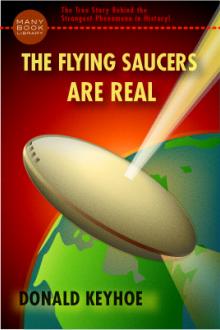The Flying Saucers are Real by Donald Keyhoe (best classic novels .TXT) 📕

- Author: Donald Keyhoe
- Performer: -
Book online «The Flying Saucers are Real by Donald Keyhoe (best classic novels .TXT) 📕». Author Donald Keyhoe
“Maybe not,” said Jack, “but why would they want to plant this foo-fighter idea?”
I showed him the clipping. He read it over and shook his head.
“That’s a lot different from disks three hundred feet in diameter.”
“If we got the principle—or Russia did-building big ones might not be too hard.”
“I still can’t swallow it,” said Jack. “These things have been seen all over the world. How could they control them that far away—and be sure they wouldn’t crash, where somebody could get a look and dope out the secret?”
We argued it back and forth without getting anywhere.
{p. 36}
“I’d give a lot to know Steele’s angle,” I said. “If you hear anything more on him, give me a buzz.”
Jack nodded. “I’ll see what I can do. But I can’t dig too hard, or he’ll hear about it.”
On the way out, I found a phone booth and called Splitt.
“Foo fighters?” he said. “Sure, I remember those stories. You think those are your flying saucers?”
I could hear him snicker.
“Just checking angles,” I said. “Didn’t the Eighth Air Force investigate the foo fighters?”
“Yes, and they found nothing to back up the pilots’ yarns. just war nerves, apparently.”
“How about a look at the Intelligence report?” I asked.
“Wait a minute.” Splitt was gone for twice that time, then he carne back. “Sorry, it’s classified.”
“If all this stuff is bunk, why keep the lid on it?” I demanded. I was getting sore again.
“Look, Don,” said Splitt, “I don’t make the rules.”
“Sure, I know—sorry,” I said. I had a notion to ask him if he knew John Steele, but hung up instead. There was no use in banging my head against the Air Force wall.
The next day I decided to analyze the Mantell case from beginning to end. It looked like the key to one angle: the question of an Air Force secret missile. Unless there was some slip-up, so that Mantell and his pilots had been ordered to chase the disk by mistake, then it would be cold murder.
I couldn’t believe any Air Force officer would give such an order, no matter how tremendous the secret to be hidden.
But I was going to find out, if possible.
{p. 37}
FOR MORE than two weeks, I checked on the Godman Field tragedy. One fact stood out at the start: The death of Mantell had had a profound effect on many in the Air Force. A dozen times I was told:
“I thought the saucers were a joke-until Mantell was killed chasing that thing at Fort Knox.”
Many ranking officers who had laughed at the saucer scare stopped scoffing. One of these was General Sory Smith, now Deputy Director of Air Force Public Relations. Later in my investigation, General Smith told me:
“It was the Mantell case that got me. I knew Tommy Mantell. very well—also Colonel Hix, the C.O. at Godman. I knew they were both intelligent men—not the kind to be imagining things.”
For fifteen months, the Air Force kept a tight-lipped silence. Meantime, rumors began to spread. One report said that Mantell had been shot, his body riddled with bullets; his P-51, also riddled, had simply disintegrated. Another rumor reported Mantell as having been killed by some mysterious force; this same force had also destroyed his fighter. The Air Force, the rumors said, had covered up the truth by telling Mantell’s family he had blacked out from lack of oxygen.
Checking the last angle, I found that this was the explanation given to Mantell’s mother, just after his death, she was told by Standiford Field officers that he had flown too high in chasing the strange object.
Shallet, in the Saturday Evening Post articles, described Project “Saucer’s” reconstruction of the case. Mantell was said to have climbed up to 25,000 feet, despite his firm decision to end the chase at 20,000, since he carried no oxygen. Around 25,000 feet, Shallett quoted the Air Force investigators, Mantell must have lost consciousness. After this, his pilotless plane climbed on up to some 30,000 feet, then dived. Between 20,000 and 10,000 feet, Shallett suggested, the P-51 began to disintegrate, obviously from excessive speed. The gleaming object that
{p. 38}
hypnotized Mantell into this fatal climb was, Shallett said, either the planet Venus or a Navy cosmic-ray research balloon.
The Air Force Project “Saucer” report of April 27, 1949, released just after the first Post article, makes these statements:
“Five minutes after Mantell disappeared from his formation, the two remaining planes returned to Godman. A few minutes later, one resumed the search, covering territory 100 miles to the south as high as 33,000 feet, but found nothing.
“Subsequent investigation revealed that Mantell had probably blacked out at 20,000 feet from lack of oxygen and had died of suffocation before the crash.
“The mysterious object which the flyer chased to his death was first identified as the Planet Venus. However, further probing showed the elevation and azimuth readings of Venus and the object at specified time intervals did not coincide.
“It is still considered ‘Unidentified.’
The Venus explanation, even though now denied, puzzled me. It was plain that the Air Force had seriously considered offering it as the answer then abandoned it. Apparently someone had got his signals mixed and let Shallett use the discarded answer. And for some unknown reason, the Air Force had found it imperative to deny the Venus story at once.
In these first weeks of checking, I had run onto the Venus explanation in other cases. Several Air Force officers repeated it so quickly that it had the sound of a stock alibi. But in the daytime cases this was almost ridiculous.
I knew of a few instances in World War II when bomber crews and antiaircraft gunners had loosed a few bursts at Venus. But this was mostly at night, when the planet was at peak brilliance. And more than one gunner later admitted firing to relieve long hours of boredom. Since enemy planes did not carry lights, there was no authentic case, to my knowledge, where plane or ground gunners actually believed Venus was an enemy aircraft.
{p. 39}
Checking the astronomer’s report, I read over the concluding statement:
“It simply could not have been Venus. They must have been desperate even to suggest it in the first place.” Months later, in the secret Project “Saucer” report released December 30, 1949, I found official confirmation of this astronomer’s opinions. Since it has a peculiar bearing on the Mantell case, I am quoting it now:
When Venus is at its greatest brilliance, it is possible to see it during daytime when one knows exactly where to look. But on January 7, 1948, Venus was less than half as bright as its peak brilliance. However, under exceptionally good atmospheric conditions, and with the eye shielded from direct rays of the sun, Venus might be seen as an exceedingly tiny bright point of light… . However, the chances of looking at just the right spot are very few. It has been unofficially reported that the object was a Navy cosmic-ray research balloon. If this can be established, it Is to be preferred as an explanation. However, if one accepts the assumption that reports from various other localities refer to the same object, any such device must have been a good many miles high—25 to 50—in order to have been seen clearly, almost simultaneously, from places 175 miles apart. If all reports were of a single object, in the knowledge of this investigator no man-made object could have been large enough and far enough away for the approximate simultaneous sightings. It is most unlikely, however, that so many separated persons should at that time have chanced on Venus in the daylight sky. It seems therefore much more probable that more than one object was involved. The sighting might have included two or more balloons (or aircraft) or they might have included Venus and balloons. For reasons given above, the latter explanation seems more likely.
{p. 40}
Two things stand out in his report:
1. The obvious determination to fit some explanation, no matter how farfetched, to the Mantell sighting.
2. The impossibility that Venus—a tiny point of light, seen only with difficulty—was the tremendous metallic object described by Mantell and seen by Godman Field officers.
With Venus eliminated, I went to work on the balloon theory. Since I had been a balloon pilot before learning to fly planes, this was fairly familiar ground.
Shallett’s alternate theory that Mantell had chased a Navy research balloon was widely repeated by readers unfamiliar with balloon operation. Few thought to check the speeds, heights, and distances involved.
Cosmic-ray research balloons are not powered; they are set free to drift with the wind. This particular Navy type is released at a base near Minneapolis. The gas bag is filled with only a small per cent of its helium capacity before the take-off.
In a routine flight, the balloon ascends rapidly to a very high altitude-as high as 100,000 feet. By this time the gas bag has swelled to full size, about l00 feet high and 70 feet in diameter. At a set time, a device releases the case of instruments under the balloon. The instruments descend by parachute, and the balloon, rising quickly, explodes from the sudden expansion.
Occasionally a balloon starts leaking, and it then remains relatively low. At first glance, this might seem the answer to the Kentucky sightings. If the balloon were low enough, it would loom up as a large circular object, as seen from directly below. Some witnesses might estimate its diameter as 250 feet or more, instead of its actual 70 feet. But this failure to recognize a balloon would require incredibly poor vision on the part of trained observers—state police, Army M.P.‘s, the Godman Field officers, Mantell and his pilots.
Captain Mantell was a wartime pilot, with over three thousand hours in the air. He was trained to identify a distant enemy plane in a split second. His vision was perfect, and so was that of his pilots. In broad daylight
{p. 41}
they could not fail to recognize a balloon during their thirty-minute chase.
Colonel Hix and the other Godman officers watched the object with high-powered glasses for long periods. It is incredible that they would not identify it as a balloon.
Before its appearance over Godman Field, the leaking balloon would have drifted, at a low altitude, over several hundred miles. (A leak large enough to bring it down from high altitude would have caused it to land and be found.) Drifting at a low altitude, it would have been seen by several hundred thousand people, at the very least. Many would have reported it as a balloon. But even if this angle is ignored it still could not possibly have been a balloon at low altitude. The fast flight from Madisonville, the abrupt stop and hour-long hovering at Godman Field, the quick bursts of speed Mantell reported make it impossible. To fly the go miles from Madisonville to Fort Knox in 30 minutes, a balloon would require a wind of 180 m.p.h. After traveling at this hurricane speed, it would then have had to come to a dead stop above Godman Field. As the P-51’s approached, it would have had to speed tip again to 180, then to more than 360 to keep ahead of Mantell.
The three fighter pilots chased the mysterious object for half an hour. (I have several times chased balloons with a plane, overtaking them in seconds.) In a straight chase, Mantell would have been closing in at 360; the tail wind acting on his fighter would nullify the balloon’s forward drift.
But even if you accept these improbable factors, there is one final





Comments (0)